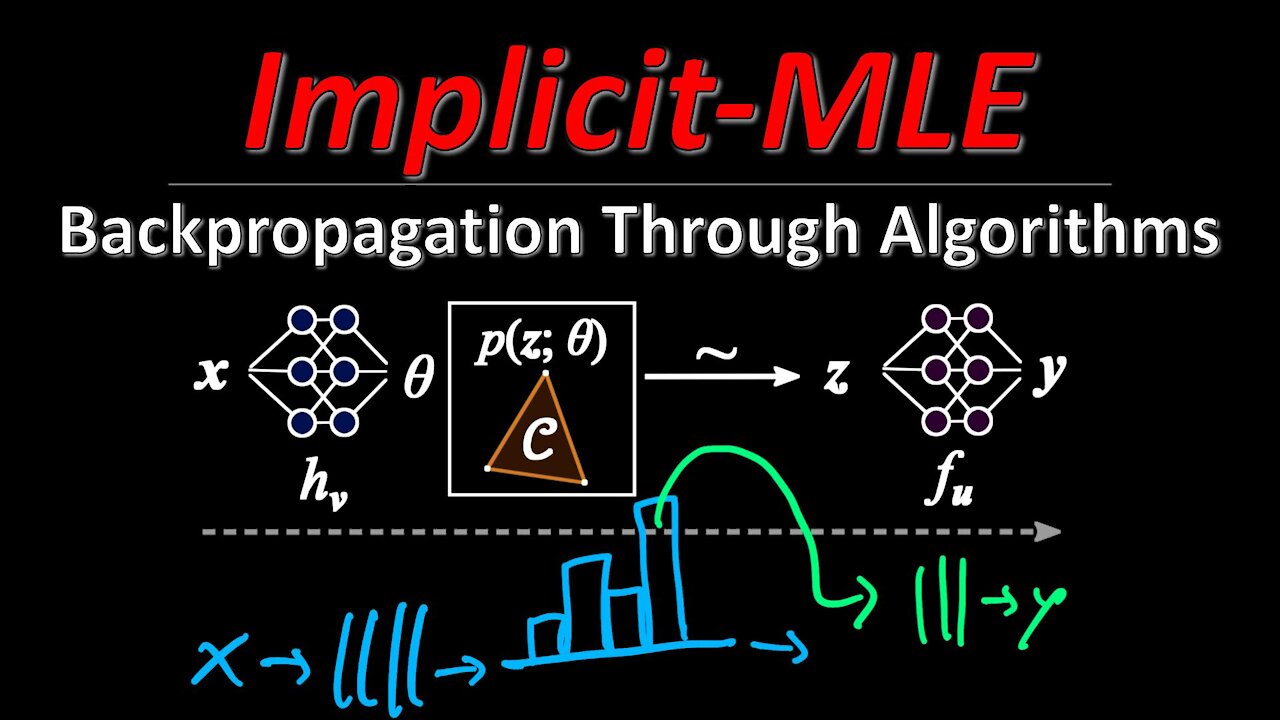Premium Only Content

Implicit MLE: Backpropagating Through Discrete Exponential Family Distributions (Paper Explained)
#imle #backpropagation #discrete
Backpropagation is the workhorse of deep learning, but unfortunately, it only works for continuous functions that are amenable to the chain rule of differentiation. Since discrete algorithms have no continuous derivative, deep networks with such algorithms as part of them cannot be effectively trained using backpropagation. This paper presents a method to incorporate a large class of algorithms, formulated as discrete exponential family distributions, into deep networks and derives gradient estimates that can easily be used in end-to-end backpropagation. This enables things like combinatorial optimizers to be part of a network's forward propagation natively.
OUTLINE:
0:00 - Intro & Overview
4:25 - Sponsor: Weights & Biases
6:15 - Problem Setup & Contributions
8:50 - Recap: Straight-Through Estimator
13:25 - Encoding the discrete problem as an inner product
19:45 - From algorithm to distribution
23:15 - Substituting the gradient
26:50 - Defining a target distribution
38:30 - Approximating marginals via perturb-and-MAP
45:10 - Entire algorithm recap
56:45 - Github Page & Example
Paper: https://arxiv.org/abs/2106.01798
Code (TF): https://github.com/nec-research/tf-imle
Code (Torch): https://github.com/uclnlp/torch-imle
Our Discord: https://discord.gg/4H8xxDF
Sponsor: Weights & Biases
https://wandb.com
Abstract:
Combining discrete probability distributions and combinatorial optimization problems with neural network components has numerous applications but poses several challenges. We propose Implicit Maximum Likelihood Estimation (I-MLE), a framework for end-to-end learning of models combining discrete exponential family distributions and differentiable neural components. I-MLE is widely applicable as it only requires the ability to compute the most probable states and does not rely on smooth relaxations. The framework encompasses several approaches such as perturbation-based implicit differentiation and recent methods to differentiate through black-box combinatorial solvers. We introduce a novel class of noise distributions for approximating marginals via perturb-and-MAP. Moreover, we show that I-MLE simplifies to maximum likelihood estimation when used in some recently studied learning settings that involve combinatorial solvers. Experiments on several datasets suggest that I-MLE is competitive with and often outperforms existing approaches which rely on problem-specific relaxations.
Authors: Mathias Niepert, Pasquale Minervini, Luca Franceschi
Links:
TabNine Code Completion (Referral): http://bit.ly/tabnine-yannick
YouTube: https://www.youtube.com/c/yannickilcher
Twitter: https://twitter.com/ykilcher
Discord: https://discord.gg/4H8xxDF
BitChute: https://www.bitchute.com/channel/yann...
LinkedIn: https://www.linkedin.com/in/ykilcher
BiliBili: https://space.bilibili.com/2017636191
If you want to support me, the best thing to do is to share out the content :)
If you want to support me financially (completely optional and voluntary, but a lot of people have asked for this):
SubscribeStar: https://www.subscribestar.com/yannick...
Patreon: https://www.patreon.com/yannickilcher
Bitcoin (BTC): bc1q49lsw3q325tr58ygf8sudx2dqfguclvngvy2cq
Ethereum (ETH): 0x7ad3513E3B8f66799f507Aa7874b1B0eBC7F85e2
Litecoin (LTC): LQW2TRyKYetVC8WjFkhpPhtpbDM4Vw7r9m
Monero (XMR): 4ACL8AGrEo5hAir8A9CeVrW8pEauWvnp1WnSDZxW7tziCDLhZAGsgzhRQABDnFy8yuM9fWJDviJPHKRjV4FWt19CJZN9D4n
-
 8:42
8:42
Chris Williamson
1 year agoThe Harsh Reality Of Our Collapsing Birthrate - Jordan Peterson
41.1K22 -
 4:33:31
4:33:31
Alex Zedra
12 hours agoLIVE! Playing Split Ficition!
70.7K9 -
 2:51:38
2:51:38
TimcastIRL
13 hours agoGovernment SHUTDOWN IMMINENT, Democrats Vow To BLOCK Trump CR w/The Native Patriot | Timcast IRL
209K111 -
 3:38:57
3:38:57
Digital Social Hour
1 day ago $22.97 earnedAndrew Tate EXPOSES the Truth About Legal Battles, Politics & Masculinity | Andrew Tate DSH #1231
87K23 -
 2:26:29
2:26:29
Laura Loomer
13 hours agoEP108: Dems Embrace Domestic Terrorism To "Get Trump"
79.7K38 -
 3:01:51
3:01:51
Right Side Broadcasting Network
15 hours agoWATCH: NASA’s SpaceX Crew-10 Launch
146K49 -
 2:06:17
2:06:17
Glenn Greenwald
14 hours agoJudge Orders Hearing on Columbia Student Deportation Case; Is the Ukraine Ceasefire Plan Serious? Trump Attacks Thomas Massie for His Budget Vote | SYSTEM UPDATE #422
150K224 -
 47:16
47:16
BonginoReport
17 hours agoTrump-Elon Bromance Triggers The Libs (Ep.03) - 03/12/2025
179K328 -
 4:03:41
4:03:41
Barry Cunningham
18 hours agoTRUMP DAILY BRIEFING: PRESIDENT TRUMP PRESS CONFERENCE | DEMOCRATS IN PANIC!
114K98 -
 1:56:30
1:56:30
Melonie Mac
16 hours agoGo Boom Live Ep 40!
67.3K13